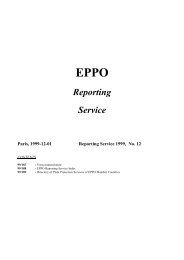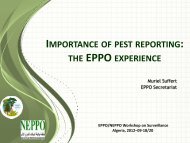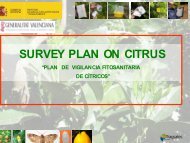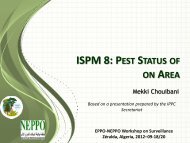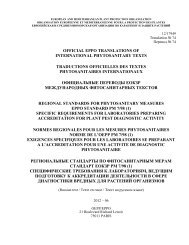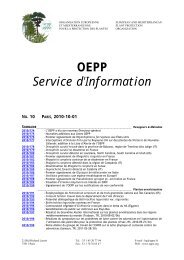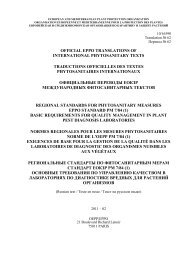EPPO Reporting Service - Lists of EPPO Standards - European and ...
EPPO Reporting Service - Lists of EPPO Standards - European and ...
EPPO Reporting Service - Lists of EPPO Standards - European and ...
Create successful ePaper yourself
Turn your PDF publications into a flip-book with our unique Google optimized e-Paper software.
<strong>EPPO</strong> <strong>Reporting</strong> <strong>Service</strong> – Pests & Diseases<br />
Because D. suzukii is currently spreading <strong>and</strong> causing damage to fruit crops in North<br />
America, <strong>and</strong> has also been introduced into Europe, the <strong>EPPO</strong> Secretariat decided to add it<br />
to the <strong>EPPO</strong> Alert List.<br />
Drosophila suzukii (Diptera: Drosophilidae – spotted wing drosophila)<br />
Why Drosophila suzukii is an Asian pest <strong>of</strong> fruit crops which has almost simultaneously<br />
been introduced into North America <strong>and</strong> in Italy (in 2008 <strong>and</strong> 2009, respectively).<br />
Because the pest has a high potential for spread <strong>and</strong> can cause economic damage<br />
to many fruit crops, the <strong>EPPO</strong> Secretariat decided to add D. suzukii to the Alert<br />
List.<br />
Where <strong>EPPO</strong> region: Italy (province <strong>of</strong> Trento - Trentino-Alto Adige region), Russia (Far<br />
East).<br />
Note: Hauser et al. (2009) mention that D. suzukii has been found in October<br />
2008 in Spain near Barcelona. The <strong>EPPO</strong> Secretariat is currently verifying this<br />
information. In their paper, it was also mentioned that unconfirmed records had<br />
been made from Montpellier <strong>and</strong> the Alps in France, but the French NPPO<br />
confirmed that D. suzukii has not been reported from its territory <strong>and</strong> that no<br />
specimens have ever been sent to their <strong>of</strong>ficial laboratories for identification.<br />
Asia: China (Guangxi, Guizhou, Henan, Hubei, Yunnan, Zhejiang), India<br />
(Ch<strong>and</strong>igarh, Jammu <strong>and</strong> Kashmir, Uttar Pradesh), Japan (Hokkaido, Honshu,<br />
Kyushu, Ryukyu), Korea Republic (including Cheju isl<strong>and</strong>), Myanmar, Russia<br />
(Primor’e region - Far East), Thail<strong>and</strong>.<br />
North America: Canada (British Columbia, first found in autumn 2009 in the<br />
Fraser Valley area <strong>and</strong> caught in a cherry orchard in the Central Okanagan<br />
Valley), USA (Hawaii introduced into the 1980s; California (2008), Oregon (2009),<br />
Washington (2009)).<br />
On which plants D. suzukii has a wide host range <strong>and</strong> can attack many fruit crops, including small<br />
fruit crops, fruit trees <strong>and</strong> grapevine. Its host range includes: Actinidia spp.<br />
(kiwis), Diospyros kaki (persimmons), Ficus carica (figs), Fragaria ananassa<br />
(strawberries), Malus domestica (apples), Prunus avium (sweet cherries), P.<br />
domestica (plums), P. persica (peaches), Pyrus pyrifolia (Asian pears), Rubus<br />
armeniacus (Himalayan blackberries), R. loganobaccus (loganberries), R. idaeus<br />
(raspberries), R. laciniatus (evergreen blackberries), R. ursinus (marionberries),<br />
<strong>and</strong> other blackberries (Rubus spp.), Vaccinium spp. (blueberries), Vitis vinifera<br />
(table <strong>and</strong> wine grapes).<br />
Damage Although the vast majority <strong>of</strong> Drosophila species are not fruit pests (larvae<br />
developing only in damaged or rotting fruits), D. suzukii is one <strong>of</strong> the very few<br />
Drosophila species which are able to feed on healthy ripening fruit while they are<br />
still attached to the plant. Damage is caused by larvae feeding on fruit pulp<br />
inside the fruit <strong>and</strong> berries. Very rapidly, infested fruit begin to collapse around<br />
the feeding site. Thereafter, secondary fungal or bacterial infections may<br />
contribute to further fruit deterioration (i.e. rotting). In the USA, severe losses<br />
have been reported in cherry production in California (estimated at 25% statewide<br />
in 2009). Several berry growers in California, Oregon <strong>and</strong> Washington, <strong>and</strong><br />
peach growers from Oregon have reported up to 100% crop losses in some fields.<br />
Adults are brownish yellow flies with black b<strong>and</strong>s on the abdomen, <strong>and</strong> bright red<br />
eyes. Males (2.6 - 2.8 mm long) have a dark spot along the front edge <strong>of</strong> each<br />
wing (hence its English common name), <strong>and</strong> two rows <strong>of</strong> combs on each fore<br />
tarsus. Females (3.2 - 3.4 mm long) do not have spots on their wings, nor tarsal<br />
combs. On average, females can lay 1 to 3 eggs at each oviposition puncture (<strong>and</strong><br />
more than 300 eggs in their lifetime), but as many females may visit the same<br />
piece <strong>of</strong> fruit up to 60-70 insects may emerge from a single fruit. Larvae (up to<br />
3.5 mm) have white cylindrical bodies, tapered in their anterior part with<br />
elevated posterior spiracles. There are three larval instars before pupation takes<br />
place. Pupae (2-3 mm long) are reddish brown with two small projections at the<br />
end, <strong>and</strong> can be inside or outside the fruit.<br />
5





